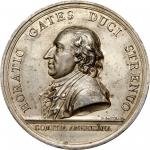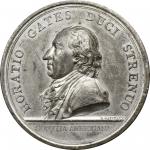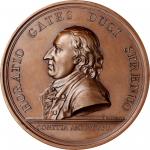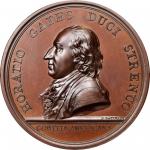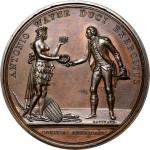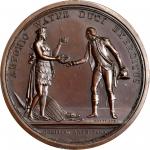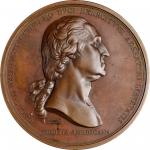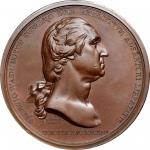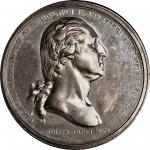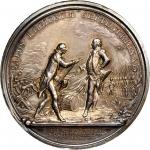1777 Horatio Gates at Saratoga medal. Betts-557. Silver. Original striking. Paris Mint. 55.8 mm, 1511.8 grains. 4.8 - 5.1 mm thick. About Uncirculated.Plain concave edge, witness line or collaring mark near 11:00 relative to the obverse. One of just three examples known in silver, the only one outside of an institution and available to private collectors. Violet and pale blue tones dominate the obverse peripheries, richest in the exergue and around GATES, while the orange and golden shades that predominate across the central obverse likewise cover much of the reverse. The fields retain good reflectivity despite some fairly trivial hairlines. Non-numismatic handling is responsible for the friction on the highest relief of the remarkable portrait of Gates, as well as the scattering of marks seen across both sides. A nearly vertical nick just below Gates eye, and a quartet clustered in the area of the field near the space between HORATIO and GATES align with those seen on the 1914 Parsons plate, where this medal was described as showing "a few light nicks on obverse." The edge is free of bruises, though the wire rim shows some impact points. An old and faint vertical scratch runs along Gates profile at the central reverse, and some hints of jewelers rouge - evidence of an ancient polishing - remains at NU of REGIONUM and inside the wire rim atop the reverse, along with the interiors of a few letters on the obverse. The overall visual impression is enhanced by the dramatic relief, the lovely toning, and the in hand heft; it is overwhelmingly positive. Were this a common medal from the last quarter of the 18th century, it would be a lovely one. Alas, a medal from this era can be no rarer than this.<p>Die state comparison based upon illustrations of microscopic surface breaks is a treacherous sport, as cracks and chips can change in size and shape due to shadows from lighting, quality of photography, and more. The reverse of the Gates medal betrays its die state most readily, with a spalling crack (caused by a brittling of the steel die face) that spans from the rim, to the top left serif of the second N in SEPTENTRIONAL, to the base of the adjacent O, to the top of the flagpole. The available photographs of the unique gold specimen presented to Gates himself, now preserved at the New-York Historical Society, do not allow for perfect comparison, but our examination of them suggests that the die states are essentially equivalent, and this silver specimen is struck from the earliest reverse die state seen or studied. The obverse is slightly later, though the distinction is subtle. Die polishing after the creation of the trial splashers separated the external lapel fold of Gatess vest (parallel to O of HORATIO). The fold is connected on both of the trial obverse strikes in this collection (see lots 2009 and 2010) and appears connected on the unique gold piece as well, but it is subtly separated here.<p>This medal was struck sometime between the spring of 1787, when the gold medal was struck, and July 4, 1789, when Jefferson recorded three transactions with Nicolas-Marie Gatteaux: a refund of 76 livre tournois from Gatteaux to the account of the United States from an earlier overpayment, a payment of 26 livres and change "for silver medal of Gates … for U.S.," and a note to charge the United States for the 31 livres tournois he had paid to Gatteaux personally on February 22, 1787, for a silver Nathanael Greene medal which he noted as received from Gatteaux "and which I now put into their [i.e. the United States] collection." These were the silver medals intended for Washingtons set. This piece shows an essentially identical die state as the Washington-Massachusetts Historical Society piece and was likely struck at the same time.<p>At 6:00 on the edge of this piece, the number 3502 has been delicately drawn in black ink. We have seen identical inventory numbers before on a broad range of American historical medals (different numbers, of course, but identical ink, hand, and fabric). In one case, a large group of identically-marked medals was acquired by a private Georgia collector in the late 1950s; in every case, those medals had come from Fred Baldwin of London, but were of primarily American or Canadian interest, including Betts medals, important Washington medals, etc. The Charles Wharton Washington Before Boston medal in silver, sold in our March 2014 Baltimore auction, had just such a number. The buyer of this piece in the 1914 Parsons sale was listed as "Historical," an identity not found in other Chapman sale bid books reviewed for several years prior and several years hence. Presumably this was an institution of some kind, and presumably this unknown institution marked the medals that ended up being sold by Baldwins in the late 1950s. Baldwin may have had an American source who placed the collection in London to add some level of exoticism (and not embarrass the deaccessioning institution); the October 1968 Glendinings sale, for instance, featured Washington medals consigned by John J. Ford, Jr. that had been previously owned by George Fuld. Museums were frequent sellers of numismatic items in the 1950s. The Maryland and New Jersey Historical Societies both consigned medals to Sotheby Parke-Bernet sales in the 1960s, the University of Pennsylvania and American Philosophical Societies both sold major holdings privately in this era, and other institutions similarly raised cash by selling their coin and medal cabinets. Someday, we may discover which institution formed, then dispersed, what must be considered one of the all-time great American medal collections, one that included not one but two original Comitia Americana medals in silver!<p>The Horatio Gates at Saratoga medal is one of seven Comitia Americana medals to have been struck in gold. The original gold presentation piece for General Gates is one of four that still exists, and like the other three, it is permanently off the market in a major institution (the others are Nathanael Greene, George Washington, and Anthony Wayne). Gates medal has been the property of the New-York Historical Society since 1889, given to them by the great-grandson of his trusted colleague at the Battle of Saratoga, Ebenezer Stevens. Stevens commissioned Gilbert Stuart to paint Gates in 1793; Stuarts portrait, depicting Gates wearing an exaggeratedly large version of his gold medal, hangs in New Yorks Metropolitan Museum of Art, just across Central Park from the medal itself. Stevens son was Gates godson and namesake: Horatio Gates Stevens. When Gates second wife made out her will, it ordered that the younger Stevens receive "the large Gold Medal which was given by Congress to my late dearly beloved and revered husband, General Horatio Gates … with the injunction from me to my Legatee, never to forget that the medal I leave him, was a distinguished testimonial of important services rendered to America, and that he bears the name of one who was a Hero, a Patriot, and a man of unsullied probity and honor."<p>With Gates gold medal off the market (and, thankfully, well appreciated and on display in New York), an original striking in silver is the most noble form of this medal that can be collected. There are but three: Washingtons silver example in the cased set at the Massachusetts Historical Society, the example in Viennas Kunsthistoriches Museum, and this one. While a silver example from these dies appeared in the 1925 W.W.C. Wilson sale as lot 803, that piece was struck with a flatter exterior rim, shows a later die state (most notably at the interior reverse rim above ON of SEPTENTRIONAL), displays filing at the usual rim cud at the left side of the reverse exergual line, and was described as a condition utterly unimaginable for a silver original: "Proof." The Wilson piece was undoubtedly a U.S. Mint restrike from these dies. Adams and Bentley note R.W. Julians statement that in 1801 "Adam Eckfeldt had struck twelve silver" specimens but mused that this was "highly unlikely given that only one of the four listed in our census could have been made in Philadelphia." The Wilson piece is the one to which Adams and Bentley refer, and your cataloger hasnt an iota of doubt of its Philadelphia origin. <p>The only other reference to a silver Gates medal in the historical record appears in the 1854 <em>Annual Report of the President of the Maryland Historical Society</em> among an inventory of medals once in the collection of Joel Barlow, then the property of the Society. Barlow was in Paris from 1788 to 1792, then later returned as the United States Minister to France in 1811. In 1852, his collection of coins and medals was donated to the Society, a hodgepodge of ancient coins, modern world coins, American coins (one described as "U.S. of America, 1792" sounds interesting), and medals. These were divided into "volumes," of which Volume 11 was described as: "2 American Washington medals, 1796, silver; 1 American silver Jefferson medal, 1801; 1 American silver Gen. H. Gates medal, 1777; 1 U.S. 3 cent coin, 1851; 2 Massachusetts shillings of 1652." The silver Washington medals were, presumably, two of the famous Seasons medals intended to be awarded to Native Americans. The 1801 Jefferson medal could have been an inaugural medal or an Indian Peace medal. The Gates medal could only have been one of these. Harlow was in Paris when the originals were struck, which is suggestive. He was not in the United States when the Burr restrikes were made in 1801 (he returned to live in Washington DC 1805 to 1811), but he was clearly close to the Gates family - Horatio Gates widow left the generals papers to Barlow, and they were given by Barlow (via Robert Fulton, of all people) to the New-York Historical Society before he left for Paris in 1811. So Barlows silver medal could have been an original - like, for instance, this one - or it could have been an 1801 restrike (like, for instance, the W.W.C. Wilson specimen). As far as we can tell, it is no longer at the Maryland Historical Society.<p>The present example was last offered for sale in the legendary 1986 Dreyfuss sale. It appears on the public market record just one other time with certainty - the 1914 Parsons sale - and is quite likely the same specimen that sold in the 1882 Bushnell sale as well. A well-funded institution could make the Gates in Saratoga medal permanently uncollectible in silver. A slightly better funded private collector could ensure the ability for future individuals to own what is unquestionably one of the most important American medals extant.<p><strong>The Battle of Saratoga</strong><p><strong>The Action:</strong><p>In the summer of 1777, the British military in North America sought to cleave the rebellious colonies in two. While Sir William Howe sailed up the Chesapeake Bay and landed troops at the Head of Elk to campaign against the rebel seat at Philadelphia, General John Burgoyne marched along the Champlain Valley water route from Canada - south via Lake Champlain, Lake George, and the Hudson River on the way to Albany. Burgoynes goal was to control the Champlain and Hudson valleys, and he endeavored to own this major north-south passage, with British held positions in Canada and New York City at either end, thereby cutting New England off from the mid-Atlantic states. Starting south across the border, Burgoynes force of nearly 8,000 consisted of about half British regulars supplemented with German mercenaries, Loyalists, and native allies. They took Fort Ticonderoga with little effort in July, but suffered a setback at the Battle of Bennington in August.<p>The Continental Army of the Northern Department, aided by the Bennington victory, saw its numbers swell in late August. Major General Horatio Gates took command on August 19, replacing Major General Phillip Schuyler. Even as Washington was charged with slowing Howes inevitable descent on Philadelphia, he saw opportunity against Burgoynes force. He sent Gates one of his most skilled officers - Benedict Arnold - along with Major General Benjamin Lincoln and the expert riflemen who served under Col. Daniel Morgan. <p>Gates first met Burgoyne at the Battle of Freemans Farm on September 19, 1777, the same week as Washingtons disaster at the Battle of Brandywine outside Philadelphia. Gates retreat preserved his force, while Burgoynes victory cost him hundreds of men. Burgoyne waited for his army to regain strength, fully expecting reinforcements to his depleted force. Gates knew his reinforcements were unlikely to appear.<p>On October 7, at the Battle of Bemis Heights, Gates and Burgoyne met once again. Gates had both superior numbers and superior intelligence; he also had Benedict Arnolds maverick plans and frenetic energy to both capitalize upon and control. Arnold led an American attack that took control of a position called the Breymann Redoubt, forcing the British troops to move. In two days, Burgoynes men found themselves hopelessly surrounded. After a weeks worth of negotiation and conversation, including a Council of War on October 13, Burgoyne agreed to surrender his entire army. Thousands of British and German troops were kept as prisoners of war, and the victory enabled Benjamin Franklin and others to successfully lobby King Louis XVI to assist the American effort.<p>Gates was proud of his role in this history-making triumph over the nation of his birth, writing to his wife on the day of the surrender "If Ole England is not by this lesson taught humility, then she is an obstinate old slut, bent upon her ruin."<p><strong>The Resolution:</strong><p><em>Resolved, That the thanks of Congress, in their own name, and in behalf of the inhabitants of the thirteen United States, be presented to Major General Gates, commander in chief in the northern department, and to Majors General Lincoln and Arnold, and the rest of the officers and troops under his command, for their brave and successful efforts in support of the independence of their country, whereby an army of the enemy of 10,000 men has been totally defeated, one large detachment of it, strongly posted and entrenched, having been conquered at Bennington, another repulsed with loss and disgrace from Fort Schuyler, and the main army of six thousand men, under Lieutenant General Burgoyne, after being beaten in different actions and driven from a formidable post, and strong entrenchments, reduced to the necessity of surrendering themselves upon advantageous to these states, on the 17 day of October last, to Major General Gates; and that a medal of gold be struck under the direction of the Board of War, in commemoration of this great event, and in the name of these United States, presented by the president to Major General Gates.</em><p><em>- Continental Congress Resolution of November 4, 1777</em><p><strong>The Acquisition:</strong><p>The day after Congress resolved to award Gates a gold medal, Henry Laurens of South Carolina wrote to the victorious general from Congress temporary seat in York, Pennsylvania in his capacity as President of Congress. <p><em>I feel myself particularly happy in the honour of transmitting the enclosed vote of thanks by Congress in their own name and in behalf of their constituents to yourself, to Major General Lincoln, Major General Arnold and the rest of the officers and troops under your command, with an additional vote for perpetuating the remembrance of this great event by a medal.</em><p><em>Your name Sir will be written in the breasts of the grateful Americans of the present age and sent down to posterity in characters which will remain indelible when the gold shall have changed its appearance. Permit me, sir, to add that I participate not only in the general rejoicing but in that also which is visible among your very best friends.</em><p>General Gates was anxious to receive his medal even before the war ended. In June 1779, he wrote again to Laurens, saying "I believe I am to wait until you are again President, before I shall receive my medal."<p>As it turned out, Gates medal was among the first for which arrangements were made. David Humphreys was the first American emissary to Paris charged with working on the Comitia Americana project, carrying instructions given by Robert Morris in June 1784. Humphreys, who served as secretary of the legation to Paris, engaged with Louis XVIs preferred medalist of the day, Nicolas-Marie Gatteaux, to execute the Gates medal. This process enters the known written recorded record in December 1785, when Jefferson is informed by Gatteaux that theres a problem with the portrait of Gates he was given: the general is depicted wearing the eagle badge of the Society of the Cincinnati, first instituted in 1784. Gatteaux wrote to Jefferson - why he didnt ask Humphreys isnt clear - if the medallic portrait of Gates should include this anachronism or not. Jefferson passed Gatteauxs query on to Humphreys on December 4, 1785:<p><em>I inclose you a letter from Gatteaux observing that there will be an anachronism, if, in making a medal to commemorate the victory of Saratoga, he puts on General Gates the insignia of the Cincinnati which did not exist at that date. I wrote him in answer that I thought so too: but that you had the direction of that business, that you were now in London, that I would write to you and probably should have an answer within a fortnight, and that in the mean time he could be employed on other parts of the die.</em><p>The exact print Gatteaux was first given is unclear, but from the portrait that Gatteaux ended up creating, its clear the eventual mother image was the popular engraving of Gates created from a portrait by Pierre Eugène du Simitière. Elvira Clain-Stefanellis suggestion that Gatteaux was initially using the extraordinarily crude engraving by John Norman seems highly unlikely.<p>The historical record on the creation of the Gates medal goes silent from the end of 1785 until early 1787, but clearly progress was being made.<p>The gold Gates medal had not been completed by the end of March when the March packet sailed for New York. On March 21, 1787, in the transmittal letter for Nathanael Greenes gold medal from William Short to John Jay, Short noted "the medal for Genl. Gates ordered by Congress and contracted for by Colo. Humphries (sic) is not yet finished; but will certainly be in time to be sent by the May Packet." The next day, in a letter to Jefferson, Short sounded less certain. "Mr. Walton who set out this morning for Havre took charge of the medals for Congress, that is those of Genl. Greene," Short wrote. "I have heard nothing farther from the engraver of Genl. Gatess."<p>Just a few days later, Short - who clearly had taken on responsibility for the Gates medal by this point - updated Jefferson again. "General Gatess medal is at length advanced to that point at which by the contract the engraver is entitled to receive 1200 [livres tournois]. I have told him I would write to you on the subject. He promises to finish it, without fail, in time to go by the May Packet. I think the likeness is very good considering the manner in which it has been taken." Jefferson forwarded an order for 1200 livres, drawn on the banker Ferdinand Grand, to Short on April 7 "for the workman who makes Genl. Gatess medal." On April 24, Short acknowledged the order had been received and paid over to Gatteaux. The deal had been completed.<p>In a wide-ranging and lengthy letter to John Jay dated May 4, 1787, Jefferson noted in his eleventh paragraph "I am in hopes Mr. Short will be able to send you the medals of General Gates by this packet. I await a general instruction as to these medals. The academies of Europe will be much pleased to receive each a set." <p>Short did not disappoint, addressing Jay the same day. "Sir, I have the honor of forwarding to your Excellency by M. de Crevecoeur the medal for Genl. Gates mentioned in my letter sent by Mr. Walter and accompanying that of Genl. Greene. M. de Crevecoeur takes charge also of twenty four medals of bronze to be delivered to your excellency. These have been made agreeably to the contract with Colo. Humphries (sic)."<p>The Gates medal was hand carried to the American continent by French writer and diplomat John Hector St. John de Crevecoeur, usually known as simply Crevecoeur, then serving as French consul at New York. Crevecoeur left Paris bound for New York on May 7, 1787, and in a letter from William Short to Jefferson the following day Short noted "Crevecoeur has gone for Havre, to sail from thence the 10th. He took with him the medals of Genl. Gates." Crevecoeur landed in New York in late June 1787 on board the Courrier de lEurope, carrying a letter of introduction to James Madison and accompanied in the passenger compartment by none other than John Paul Jones. Upon his arrival, Crevecoeur likely delivered the Gates medals - one in gold, 23 in bronze - to John Jay, who then delivered Gates own medal to Arthur St. Clair, the President of Congress.<p>Jefferson received and paid for the silver Gates medal struck for presentation to George Washington on July 4, 1789.<p><strong>The Presentation:</strong><p>The August 1787 presentation of Gates gold medal was a reunion of sorts. The medal was delivered into Gates hands by letter from Arthur St. Clair, whose abandonment of Fort Ticonderoga in July 1777 helped lead Burgoyne into Gates hands at Saratoga. Gates received St. Clairs letter of August 9, 1787 at his home, Travelers Rest, in what was then Berkeley County, Virginia and is today near Kearneysville, Jefferson County, West Virginia. He thanked St. Clair profusely on August 31, 1787.<p><em>Sir:-I had the honor to receive your Excellencys letter of the 9th inst., with the elegant medal in gold, which the most honorable the Congress, in their names, and in behalf of the inhabitants of the thirteen United States, were pleased to direct the Board of War to have struck and presented to me. Nothing could add to this distinguished mark of the favor and approbation of Congress but my receiving it in so polite a manner from the hands of your Excellency; from you, sir, whom, in the course of thirty years, I have so often had the honor to accompany on a vast variety of military service. </em><p><em>Permit me, likewise, to declare the satisfaction I feel in seeing your Excellencys merits crowned by the high station you now fill with such acknowledged ability. That the prosperity, honor, and happiness of the United States may last to the end of time, and that your Excellency may continue to enjoy the best blessings fortune can bestow, is my constant, ardent wish.</em><p><strong>The Horatio Gates at Saratoga Medal:</strong><p><strong>Obverse:</strong> A portrait of Gates to left, apparently based upon the Gates portrait by Pierre Eugène du Simitière; the dress is either civilian or intended to be military but mistakenly lacking his epaulet. Legend HORATIO GATES DUCI STRENUO (Horatio Gates, valiant general or energetic leader). COMITIA AMERICANA (American Congress) in exergue.<p><strong>Reverse:</strong> Gates upright at right, holding his hat and extending his right hand, Burgoyne on bent knee offering sword at left. Burgoynes troops, in left background, furl flags and lay down their arms. An artillery piece points away. At center background, a furled flag is laid over a drum. At right left background, American troops stand tall with shouldered arms surmounted by bayonets. A sword-wearing officer stands in front of the American line. A single flag is raised at right. At left end of the exergual line, a grouping of cannonballs. At right end, a victory laurel. Main legend SALUS REGIONUM SEPTENTRIONAL (Safety in the northern regions). In exergue, HOSTE AD SARATOGAM INDEDITION ACCEPTO DIE XVII OCT MDCCLXXVII (Advancing to the surrender of Saratoga, October 17, 1777). <p><p>From the John W. Adams Collection. Acquired from Bowers and Merena / Presidential Coin and Antique Co.’s sale of the David W. Dreyfuss Collection, April 1986, lot 5237. Earlier, probably the specimen in S. Hudson and Henry Chapman’s sale of the Charles I. Bushnell Collection, June 1882, lot 1612 (sold to Ed. Frossard, who in 1885 cataloged the first auction offering from the consignor of the following); Henry Chapman’s sale of the Hon. George M. Parsons Collection, June 1914, lot 2117; sold to “Historical;” unknown intermediaries to the Dreyfuss Collection. Plated in “Back to Medal Collecting” by John W. Adams, The American Numismatic Association Anthology, 1991, p. 132.

